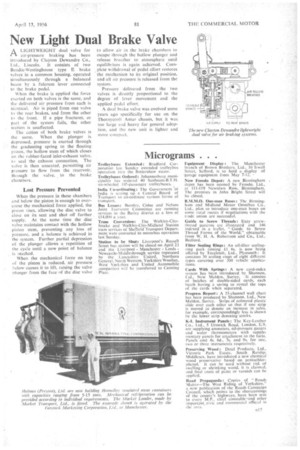New Light Dual Brake Valve
Page 51

If you've noticed an error in this article please click here to report it so we can fix it.
ALIGHTWEIGHT dual valve for air-pressure braking has been introduced by Clayton Dewandre Co., Ltd., Lincoln. It consists of two liendix-Westinghouse type E brake valves in a common housing, operated simultaneously through a balanced beam by a fulcrum lever connected to the brake pedal.
When the brake is applied the force exerted on both valves is the same, and the delivered air pressure from each is identical. Air is piped from one valve to the rear brakes, and from the other Ii the front. If a pipe fractures, or part of the system fails, the other section is unaffected.
The action of both brake valves is the same. When the plunger is depressed, pressure is exerted through the graduating • spring to the floating piston, the hollow stem of which closes on the rubber-faced inlet-exhaust valve, I'.) seal the exhaust connection. The valve is then unseated, permitting air pressure to flow from the reservoir, through the valve, to the brake chambers.
Lost Pressure Prevented When the pressure in these chambers and below the piston is enough to overcome the mechanical force applied, the piston rises, allowing the disc valve to close on its seat and shut off further supply. At the same time the disc valve maintains contact with the hollow piston stem, preventing any loss of pressure, and a balance is achieved in the system. Further partial depression of the plunger allows a repetition of the cycle until a new point of balance is reached.
When the mechanical force on top of the piston is reduced, air pressure below causes it to lift, raising the valve plunger from the face of the disc valve
to allow air in the brake chambers to escape through the hollow plunger and release breather to atmosphere until equilibrium is again achieved. Complete withdrawal of pedal effort restores the mechanism to its original position, and all air pressure is released from the system.
Pressure delivered from the two valves is directly proportional to the degree of lever movement and the applied pedal effort.
A dual brake valve was evolved some years ago specifically for use on the Thornycroft Antar chassis, but it was too large and heavy for general adoption, and the new unit is lighter and more compact.




















































































































